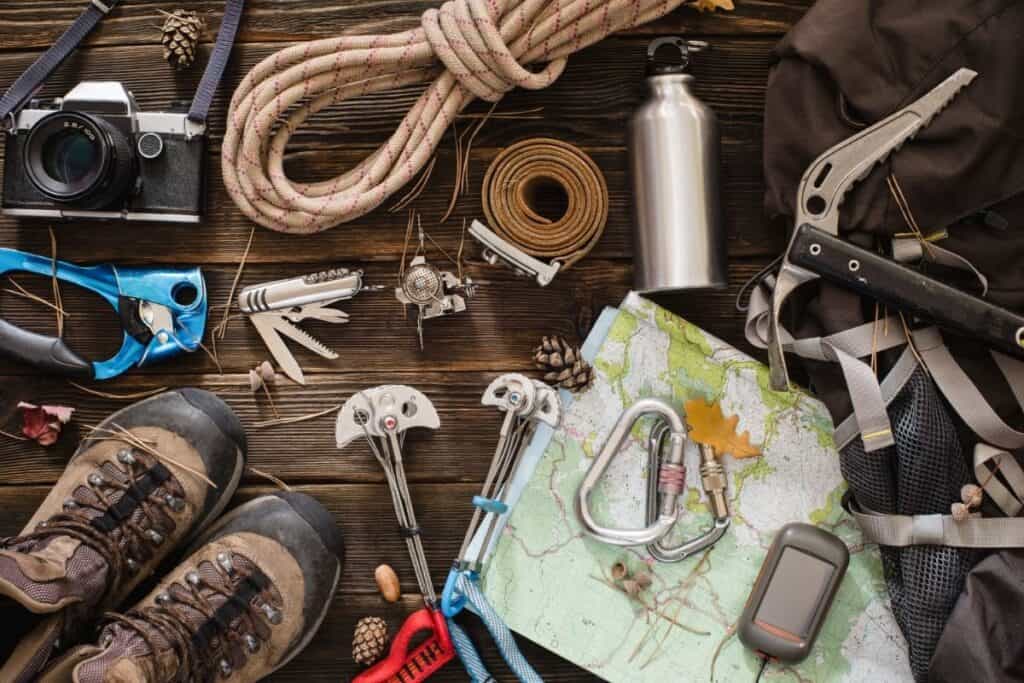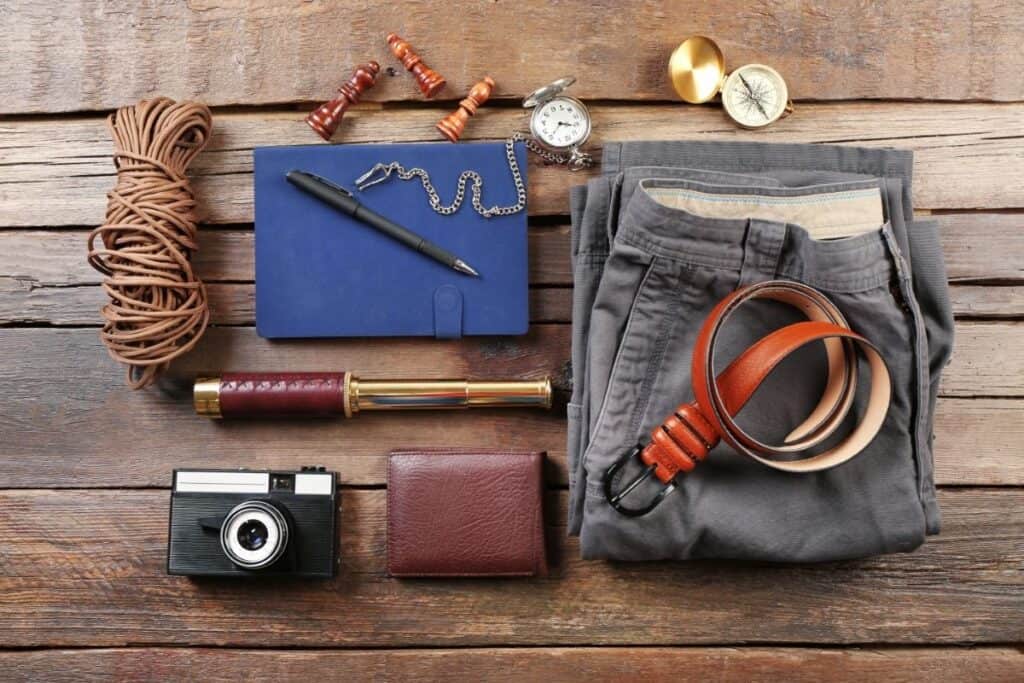
Have you ever wandered through an REI or other outdoor store and found yourself wondering why hiking gear is so expensive? After all, regular flannel shirts, rain jackets, and shoes are pretty cheap by comparison in many other places!
Hiking gear is more expensive because it is built with specialized materials and manufacturing methods to ensure that it performs well under harsh conditions for extended periods of time.
With that in mind, let’s dive in deeper to see why these factors lead to hiking gear being more expensive than everyday items.
Reason One – Materials
Hiking gear undergoes tests to its durability and utility like no other. When you go hiking, you face obstacles like deep rivers and creeks, freezing temperatures, and rough terrain. Because of all this, hiking material has to be specially made to suit outdoor needs.
If you’ve ever worn a regular jacket or pair of jeans out on a long hike, you’ve probably noticed how quickly it can get worn out. This is because standard cotton and other materials are made for the home or office’s calm, undemanding environment.
When you take these materials into the wilderness, they undergo a level of stress they’re not made to withstand.
Because of this, unique clothing material is made to withstand these conditions. The soft, rubbery material you find on a good rain jacket is excellent for variable temperatures and harsh terrain and keeps out rain.
However, since hardcore hikers are such a rare breed, the materials are more problematic for companies to manufacture and difficult to sell. This creates a price point that can get a little steep, so hikers have to fill in the gaps.
If you’ve ever felt the hurt more on your wallet after a long hike, that Arc’teryx jacket might just be the reason!
Reason Two – Quantity
To have a safe and successful hike, hikers need lots of special-made gear for their unique purposes. Things can get a bit pricey with so much to buy, and frequent trips can become a burden on the hiker’s wallet.
Let’s get a run-down of all the needs that must be met while you’re in the wilderness. For one, there’s thirst.
Being stuck in the wilderness without a good filter or package of iodine tablets can be a real killer if you’re not careful. Walking ten miles without a sip of water in your system – now that hurts!
To prevent this, hikers need decent filters with filter replacements, or at the very least a box or two of Aquatabs. These materials alone can be expensive, and we haven’t even gotten to the most costly needs.
Shelter probably runs you your most significant expense. A good tent can be anywhere from $200 to $500 dollars, depending on how many people you need to fit inside of it. Pair this with rain flies, matches, mosquito nets, and other accouterments, and you’ve got a serious price tag on your hands.
Aside from this, hikers will also see a considerable portion of their spending go towards food. While a few packs of ramen and nuts for trail mix might not be so expensive for one run, keep buying them, and they’ll get to be a real burden.
If you’re health-conscious, you might also notice a marked uptick in costs. Healthier trail foods like jerky, dried fruit, and mixed nuts are expensive, and hikers often find it challenging to balance nutrition and cost.
Reason Three – Market Forces
For this one, we’re going to have to take a trip back to ECON 101 and talk about why the hiking gear marketplace is set up to make gear more costly.
When you go through your local Dick’s or REI, you might notice various brands – Patagonia, Coleman, Ozark, North Face, and Osprey, to name just a few.
It can become a daunting task just figuring out which company makes the best jacket, much less something more complex like a UV water purifier!
However, if you go asking around, you might find that most people aren’t hikers. So, do we need so many brands?
Having so many brands competing for the business of so few hikers creates a situation where each company can only sell a few of its items at a time. If you’re trying to make a profit, this is a bad thing.
To make up for the gaps between expenditures and earnings while also selling fewer goods, companies have to charge their customers more.
So, when you pay a hundred dollars for a jacket that feels like it’s made of Ziploc bags, it’s because you’re paying for all the shipping, manufacturing, and labor costs that have to be covered over a fewer number of sales.
For easy numbers, let’s say that they needed to recoup $100 in costs over 10 sales. It’s easy to see that it would require $10 per sale to cover the original $100. However, it they sold ten times as much, they’d only need to add $1 per sale to recoup the same $100.
This is one element of “economies of scale” that allows a business to operate more efficiently, and pass down costs savings to a consumer.
Lots of industries are like this, but hiking is a prime example of an oversaturated industry. In these industries, the number of businesses in competition is too large for the consuming public to support without upcharges.
Reason 4 – Conservation
If you’re a plastic bag manufacturer, you probably don’t care whether or not your customers throw out your bags after they’ve been used. In fact, you probably want to keep customers from reusing them so you can sell more.
Making a higher profit off of disposable items is a significant factor driving the American throw-away culture. If Americans use plastic cups, plates, and silverware, wear flashy clothes made from shabby material, and use phones programmed to break in four years, they’ll inevitably come back to buy more.
However, this doesn’t quite work the same inside of the hiking industry. Disposable materials clothing, tools, and so on – create a lot of waste, which has to be disposed of somehow. To do this, land must be dug up and turned into landfills. That’s a lot of nature that can never be recovered.
Additionally, disposable material is hard to keep track of on the trail, and less careful hikers might be tempted to throw it out. This creates a lot of litter, which detracts from the visual beauty of a park.
Put these together, and you’ve got the perfect recipe for decimating the very areas hikers love to go trekking through. If these places aren’t pristine, hikers go hiking less and buy less gear.
Gear manufacturers are often conservationists for this reason. Disposable materials hurt the bread and butter of their industry and undermine their ability to make money.
But it’s not all profit that drives industry giants. Some companies are founded by passionate hikers who love to see the planet healthy and thriving and want to leave it better than they found it for future generations.
This is not a cheap task, however, as reusable materials have to be durable. To create durable materials, unique manufacturing methods have to be employed. Take, for example, your average Walmart flannel. Sure, you could load it up with durable material and tight stitching, but ultimately, most buyers won’t need it. Sitting in a chair all day doesn’t exactly tear clothing up.
The close, durable stitching and sturdy materials that go into making reusable clothing and gear are expensive and time-consuming, and thus labor costs go up. Hikers, unfortunately, shoulder that burden.
How Can I Bring Costs Down?

Hikers often find that their first trip is their most expensive. As we stated before, hiking gear is made to be reused, so you don’t have to buy a fresh outfit for every outing. You will also get better at judging what you need and how much of it will be enough.
A hiker’s first trip can put a dent in their savings. From the cost of durable clothing to the innumerable trinkets and tools needed to survive a single night in the woods, non-hikers would be surprised at what we spend just to indulge our addiction for a weekend.
Additionally, that UV water purifier we mentioned before – you might find that it doesn’t have a noticeable advantage over plain old Aquatabs. You might find that you only need one filter replacement instead of four, or maybe that six gas canisters for your rocket stove were way too many.
Take all of this into account, learn from your mistakes, and reuse your materials to get your costs down to a manageable level. After just a few hikes, you’ll be a professional at satisfying your needs with as little gear as possible.
To conclude this article, I’ll say that we, too, have felt the hiker’s-wallet blues, but you shouldn’t lose hope! A lot of the cost of a hiking trip comes from useless equipment, and many hikers find that they only have to buy new gear once or twice a trip.
However, that first trip is likely to stay pricey due to the quantity of gear needed, the oversaturated hiking markets, high gear quality, and hikers’ dedication to conservation.
Related Articles
Make sure to take a look at these other related resources before you go!
